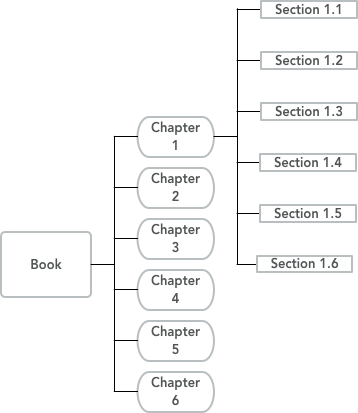About OER Development in Pressbooks
Developing a Consistent Structure
Adapted from Fanshawe OER Design Studio
When starting a textbook project, it helps to have an outline of your content prepared. Depending on your course’s content, learning context, pedagogical approach, and other factors, your outline may look very different from another author’s book.
Front Matter, Main Body, and Back Matter
Books are typically broken into three main sections: the front matter, main body, and back matter.
The front matter is the introductory section of your open text and the first thing readers see. Pressbooks will set up some of these sections for you, including a copyright page and a table of contents in exported documents. You might also choose to include one or more of the following elements:
- Acknowledgments / Dedication
- About this book
- About the authors
- Foreword / Preface
- Introduction
The back matter of a text typically includes supplements to the main text. This might include:
- Appendices
- Glossary
- References
- Suggested readings
- Image sources / Attributions
- Peer review statement
- Supplemental resources (e.g. a link to an instructor’s guide or a downloadable set of slides to accompany the book)
The main body of your text is where the bulk of the content will be provided. This content might be broken down in several ways, as we’ll discuss throughout the rest of this section.
Organizing your Text’s Content
Whatever your overall book’s structure looks like, you should have a consistent structure across your chapters.
Below are three typical textbook structures:
- Example 1:Book⟹Part⟹Chapter
- Example 2: Book⟹Chapter⟹Section
- Example 3: Book⟹Chapter⟹Section⟹Sub-section
- Example 4: Book⟹Unit⟹Chapter⟹Section⟹Sub-section
For our example, let’s say an author decides to organize their book according to example 2, i.e. Book⟹Chapter⟹Section. The book structure would look something like this for Chapter 1:

Not sure how to start? Check your syllabus!
Look at your syllabus and learning objectives as a place to start. Do you like the breakdown of units and topics you teach right now? Do you teach content in a specific order because you find that to be the most effective way of doing so, or just because the book you assign is organized that way? How could you reflect your preferred teaching style and content order in your own book’s outline?
Headings
Pressbooks provides a variety of heading levels beginning with Heading 1 (the most prominent and largest) down to Heading 6.
- The default setting in Pressbooks defines the chapter title as H1, therefore all subsequent headings within a chapter should begin with H2.
- Create a hierarchy for the sections in your chapters and note which headings you’ve assigned to each.
- Decide how words in headings will be capitalized and record this decision as well. You can create a simple style guide to track these decisions as you plot out your project.
This is what the six different headings look like.
Heading 1
Heading 2
Heading 3
Heading 4
Heading 5
Heading 6
User Navigation
When users navigate the web version of your resource, a list of its contents (chapters and parts) can be accessed through the “Contents” navigation menu. Use the plus sign (+) to expand and the minus sign (-) to collapse the content sections.
Each page in a Pressbooks page contains “next” and “previous” buttons. These buttons allow users to navigate between pages. Keyboard arrows can also be used to navigate from one page to the next.
Below is an interactive image of a typical webbook. Click on the (+) icons for more information:
This content was adapted from “Book Structure and Headings” in the Fanshawe OER Development Guide. The content has been lightly adapted for tone to match the other chapters presented. The Fanshawe Guide is available under a Creative Commons Attribution NonCommercial ShareAlike 4.0 International License. Additional content under “Front Matter, Main Body, and Back Matter” is adapted from “Open Text Outline” by Nikki Andersen; Deborah King; Adrian Stagg; and Emilia Bell, licensed under a Creative Commons Attribution-NonCommercial 4.0 International License, except where otherwise noted.
Its content was originally adapted from:
“Developing Textbook Structure” from Open Textbook Publishing Orientation (PUB 101)Modules by the University of Minnesota is offered under a Creative Commons Attribution license
“Style Guide” from Ryerson Open Textbook Authoring Guide Copyright © 2017 by Ryerson University is licensed under a Creative Commons Attribution 4.0 International License, except where otherwise noted.

